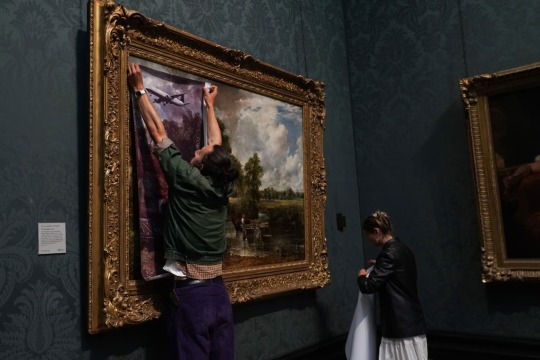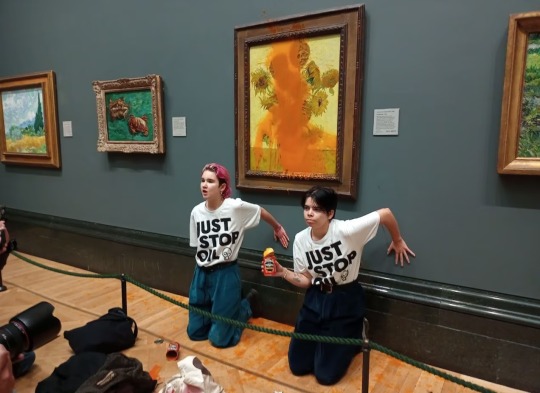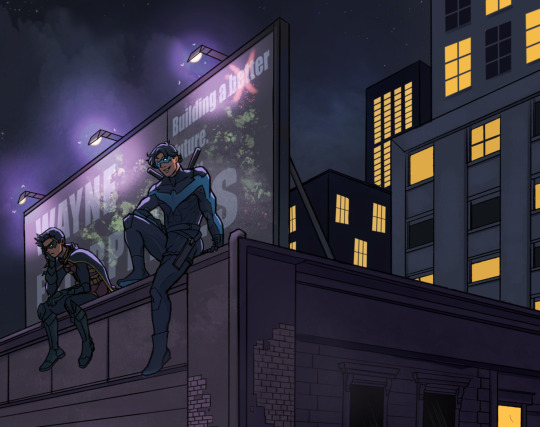#VANDALIZATION
Explore tagged Tumblr posts
Text

Literally what's happened to Disney-Marvel, Disney-Star Wars, Disney-Doctor Who, Star Trek, Lord of the Rings and major video game publishers.
They've pandered to activists to produce for a "modern audience" that doesn't exist, and alienated the audience that does exist. Instead of taking responsibility for their own actions and choices, they then attack the audience for their lack of interest.
#Star Wars#Marvel#video games#Sweet Baby Inc.#Disney Star Wars#Disney Marvel#Star Trek#Doctor Who#vandalization#vandalized#fandom#Lord of the Rings#box office bombs#go woke go broke#religion is a me#religion is a mental illness
34 notes
·
View notes
Text

Last summer, two climate activists, from Just Stop Oil, covered and glued themselves to a painting called "The Hay Wain" by John Constable hanging in London's National Gallery. The painting, which depicts an idyllic country landscape, was covered with a picture depicting a dystopian, polluted image of the same scene. Photograph By Kristian Buus, In Pictures/Getty Images
Throwing Soup At A Van Gogh? Why Climate Activists Are Targeting Art
By tossing paint and food on the glass exterior protecting famous paintings, activists say they’re conveying a powerful message—art cannot exist on a destroyed planet.
— By YessEnia Funes | July 19, 2023
When Georgia B. Smith recently walked into the Metropolitan Museum of Art on June 24, she felt nervous. The 34-year-old wasn’t there to admire 18th-century paintings alongside New York City’s summer tourists; with red marker on her hands and black tape on her mouth, she was there to disrupt.
Smith is part of a growing climate activist movement whose protests center art and museums. Since at least May 2022, environmentalists with groups like Just Stop Oil and Extinction Rebellion have been using cake, soup, paint, and glue to capture the attention of museum visitors—by marking the glass protecting art pieces and attaching themselves to the frame or wall surrounding them. Each time, their message is simple: there is no art on a dead planet.
But these climate activists say they have no interest in damaging art. Instead, they want to raise awareness about the climate emergency and attract new members. By at least one measure, their approach is working: Smith became involved with the New York City chapter of Extinction Rebellion only after protesters began focusing on museums. She had marched peacefully in defense of Black lives and women’s rights, but she had never put her body on the line—not until Extinction Rebellion.
“I saw this action at an art museum… and it was a controversial action, but I know why they’re doing this. I feel the same desperation these people are feeling,” Smith said.
Calling Attention To Climate Change
Everyone is affected by the planet’s rising temperature. July kicked off with the Earth’s hottest week on record. Meanwhile, marine heat waves are driving mass death of ocean creatures. Wildfire seasons are intensifying, leading to unprecedented air quality warnings. Farmers are struggling to grow food as soils either dry out from too little rain or wash out from too much. The result? Famine.

Last October, climate protestors from Just Stop Oil threw canned tomato soup at Vincent van Gogh's famous "Sunflowers" painting at the National Gallery in London. Photograph By Just Stop Oil, Handout/Anadolu Agency/Getty Images
While the protests’ provocative nature has drawn mixed public reactions, organizers don’t plan to change gears anytime soon—especially after the federal government criminally charged two of their peers for smearing red paint on the glass and frame of a sculpture at the National Gallery of Art in May.
Smith and about 19 others gathered in the Met that June morning to stand in solidarity with Joanna Smith and Tim Martin, the activists charged.
“Bringing the climate emergency to people’s attention should be something society rewards, not tries to punish to such an extreme degree,” said Shayok Mukhopadhyay, a spokesperson for Extinction Rebellion NYC who helped organize the protest.
The group stood before “Little Dancer Aged Fourteen”—a bronze statue similar to the same wax sculpture for which Joanna Smith and Martin now face up to 10 years in prison—with their hands colored in red marker and their lips covered with black tape. White words were stamped on the tape: “HEAT,” “WILDLIFE,” “FIRES,” “DEATH.” Georgia Smith's lips read, “FAMINE.”
What’s the Purpose of Art in a Global Crisis?
Climate protestors say they are taking to major museums, in part, because these cultural institutions aren’t telling these stories. In fact, museums like the American Museum of Natural History and Amsterdam’s Van Gogh Museum have been pressured in recent years to cut the funding they receive from fossil fuel companies, the greatest contributors to global carbon pollution.
“The function of art is for people to be able to understand the world that they live in and reflect on the human condition, but big art isn’t fulfilling that function,” Mukhopadhyay said. “That’s the reason for us to be in museums: to tell people that we are in the middle of an emergency, and it is the time now for you to face that emergency.”
Climate change is also itself a threat to art: Leading cultural institutions, the Foundation for Advancement in Conservation and the National Endowment for the Humanities, outlined in a June report the need for “immediate action” to address climate change given how it threatens cultural heritage sites, art collections, and institutions.
Museums, however, say these protests are attacks on priceless artworks. “We unequivocally denounce this physical attack on one of our works of art,” said National Gallery of Art Director Kaywin Feldman in a statement after Joanna and Martin threw paint at the “Little Dancer” exhibit.
However, Favianna Rodriguez, an artist and climate justice activist, supports these organizers. As the president of The Center for Cultural Power, which uses art to inspire action on societal issues, Rodriguez views the protests themselves as a form of art. “Protest is like theater,” she said. “It’s the creation of a counter-narrative.”
She hopes the protesters can bring more optimism and solutions into their actions. She also wants to see participants take an intersectional approach to climate protests and call out the museums for the ways they’ve historically exploited communities of color. She notes that the marginalized groups most likely to be impacted by climate change are often the most misrepresented in major museums.
“A lot of these museums are holding things that were stolen during colonization—sacred, sacred objects,” Rodrigeuz said. “These places are not just contested by climate activists. There’s been a lot of contestation around their collections, how they’ve collected, and what kind of point of view they have shown.”
Will These Protests Make a Difference?
Miranda Massie, founder and director of the Climate Museum, isn’t worried about her institution being protested next. “If museums want to protect themselves against these interventions, then they can do that very effectively by actively engaging with the climate crisis in their programming,” she said.
She supports the activists and is frustrated by the bad press surrounding their actions; Massie worries this coverage may alienate the general public.
One survey published in November of last year suggested public support of climate protests may dip after demonstrations such as pretending to deface art. A larger set of data suggest the art museum protests might be an effective call to action, though it’s too early to tell.
Dylan Bugden, an assistant professor of environmental sociology at Washington State University, researches the way people interpret social movements. Every movement is different, which creates challenges for making generalized statements, but Bugden’s findings have shown that peaceful, nonviolent protests can resonate with people who believe in climate change. He’s not sure that would be the case with something as disruptive as throwing soup in a museum, but he doesn’t believe such actions would cause harm, either.
“When we talk about climate change activism and social movement strategy, what really matters is not a one-off protest event and catching people’s attention here and there,” Bugden said. “It’s building grassroots activism and organizations that can mobilize people to vote, to protest, to take action. Building that kind of coalition is what it will take to do something about climate change.”
#Climate Activists#London's National Gallery#Van Gogh#Targeting Art#Vandalization#Georgia B. Smith#Climate Change#HEAT” | “WILDLIFE” | “FIRES” | “DEATH” | “FAMINE.”#Global Crisis#American Museum of Natural History#Amsterdam’s Van Gogh Museum#Kaywin Feldman#National Gallery of Art#Favianna Rodriguez#Miranda Massie#Climate Museum#Dylan Bugden
2 notes
·
View notes
Text




Trump’s golf course in Turnberry, Scotland was vandalized overnight by Palestine solidarity activists.
72K notes
·
View notes
Text

February 18, 2025 - Three Palestine Action activists took over the entrance to Pearson Engineering in Newcastle, an arms factory owned by Israel’s national defence group Rafael, and halted production for the day. [video]
#palestine action#free palestine#palestine#direct action#vandalism#occupation#factory#direct action gets the goods#death to israel#2025#solidarity#uk#newcastle#video
9K notes
·
View notes
Text

DC give me more of them interacting please I’m begging you
Edit: the amount of you quoting “we were the best” in the tags is giving me life
#dick grayson#dc#nightwing#my art#batman#dc comics#damian wayne#robin#batkids#batfamily#guess who vandalized the billboard#dc let me project my fantasy of a father/brother figure who sees the best in me even when I don’t deserve it
10K notes
·
View notes
Text
Me, parking lot security: Do you have any ID on you today
Person I just found keying someone’s car: I’m sorry I’m autistic
Me: Cool, me too. So a driver’s license, regional ID, anything…?
Person, now crying: I can’t get in trouble I have an anxiety disorder can I just go I have really bad anxiety
Me: Yeah me too, I feel you. But you see the car’s owner will need information to file for insurance so again if I can get your name
Person: I literally have anxiety so bad I can’t do this
Me: Listen I’m not a cop, I can’t force you to stick around, but if you do wanna help with this and you’re not gonna run then eventually someone will need to know what your name is. Can you take a few deep breaths with me
Person: (crying harder) please I’m literally autistic
Me:
Me: So again I am also autistic
#Details changed for privacy reasons#AM I MISSING SOMETHING#IS THERE AN AUTISM BLIND SPOT HERE#WHAT AM I MISSING#I hate when this happens BRUH WHAT DO YOU WANT ME TO SAY#BESTIE I ALSO HAVE ANXIETY WHY ARE YOU VANDALIZING CARS#Teablart#This happens so much and I never know what to do#Except calm them down#But what does that even MEAN#“Don’t tell anyone what I did I have ADHD”#???????????#What does having ADHD have to do with other people knowing someone fucked their shit????#HELP
4K notes
·
View notes
Text

something cosmic *ੈ✩‧₊˚
#jayvik#jayce x viktor#jayce talis#arcane jayce#arcane viktor#arcane league of legends#arcane#arcane fanart#league of legends#arcane art#yaoi#yaoi bl#anima#animation#digital artist#digital art#digital vandalism#my art#artists on tumblr#gif
4K notes
·
View notes
Text
You're a reasonably informed person on the internet. You've experienced things like no longer being able to get files off an old storage device, media you've downloaded suddenly going poof, sites and forums with troves full of people's thoughts and ideas vanishing forever. You've heard of cybercrime. You've read articles about lost media. You have at least a basic understanding that digital data is vulnerable, is what I'm saying. I'm guessing that you're also aware that history is, you know... important? And that it's an ongoing study, requiring ... data about how people live? And that it's not just about stanning celebrities that happen to be dead? Congratulations, you are significantly better-informed than the British government! So they're currently like "Oh hai can we destroy all these historical documents pls? To save money? Because we'll digitise them first so it's fine! That'll be easy, cheap and reliable -- right? These wills from the 1850s will totally be fine for another 170 years as a PNG or whatever, yeah? We didn't need to do an impact assesment about this because it's clearly win-win! We'd keep the physical wills of Famous People™ though because Famous People™ actually matter, unlike you plebs. We don't think there are any equalities implications about this, either! Also the only examples of Famous People™ we can think of are all white and rich, only one is a woman and she got famous because of the guy she married. Kisses!"
Yes, this is the same Government that's like "Oh no removing a statue of slave trader is erasing history :(" You have, however, until 23 February 2024 to politely inquire of them what the fuck they are smoking. And they will have to publish a summary of the responses they receive. And it will look kind of bad if the feedback is well-argued, informative and overwhelmingly negative and they go ahead and do it anyway. I currently edit documents including responses to consultations like (but significantly less insane) than this one. Responses do actually matter. I would particularly encourage British people/people based in the UK to do this, but as far as I can see it doesn't say you have to be either. If you are, say, a historian or an archivist, or someone who specialises in digital data do say so and draw on your expertise in your answers. This isn't a question of filling out a form. You have to manually compose an email answering the 12 questions in the consultation paper at the link above. I'll put my own answers under the fold. Note -- I never know if I'm being too rude in these sorts of things. You probably shouldn't be ruder than I have been.
Please do not copy and paste any of this: that would defeat the purpose. This isn't a petition, they need to see a range of individual responses. But it may give you a jumping-off point.
Question 1: Should the current law providing for the inspection of wills be preserved?
Yes. Our ability to understand our shared past is a fundamental aspect of our heritage. It is not possible for any authority to know in advance what future insights they are supporting or impeding by their treatment of material evidence. Safeguarding the historical record for future generations should be considered an extremely important duty.
Question 2: Are there any reforms you would suggest to the current law enabling wills to be inspected?
No.
Question 3: Are there any reasons why the High Court should store original paper will documents on a permanent basis, as opposed to just retaining a digitised copy of that material?
Yes. I am amazed that the recent cyber attack on the British Library, which has effectively paralysed it completely, not been sufficient to answer this question for you. I also refer you to the fate of the Domesday Project. Digital storage is useful and can help more people access information; however, it is also inherently fragile. Malice, accident, or eventual inevitable obsolescence not merely might occur, but absolutely should be expected. It is ludicrously naive and reflects a truly unpardonable ignorance to assume that information preserved only in digital form is somehow inviolable and safe, or that a physical document once digitised, never need be digitised again..At absolute minimum, it should be understood as certain that at least some of any digital-only archive will eventually be permanently lost. It is not remotely implausible that all of it would be. Preserving the physical documents provides a crucial failsafe. It also allows any errors in reproduction -- also inevitable-- to be, eventually, seen and corrected. Note that maintaining, upgrading and replacing digital infrastructure is not free, easy or reliable. Over the long term, risks to the data concerned can only accumulate.
"Unlike the methods for preserving analog documents that have been honed over millennia, there is no deep precedence to look to regarding the management of digital records. As such, the processing, long-term storage, and distribution potential of archival digital data are highly unresolved issues. [..] the more digital data is migrated, translated, and re-compressed into new formats, the more room there is for information to be lost, be it at the microbit-level of preservation. Any failure to contend with the instability of digital storage mediums, hardware obsolescence, and software obsolescence thus meets a terminal end—the definitive loss of information. The common belief that digital data is safe so long as it is backed up according to the 3-2-1 rule (3 copies on 2 different formats with 1 copy saved off site) belies the fact that it is fundamentally unclear how long digital information can or will remain intact. What is certain is that its unique vulnerabilities do become more pertinent with age." -- James Boyda, On Loss in the 21st Century: Digital Decay and the Archive, Introduction.
Question 4: Do you agree that after a certain time original paper documents (from 1858 onwards) may be destroyed (other than for famous individuals)? Are there any alternatives, involving the public or private sector, you can suggest to their being destroyed?
Absolutely not. And I would have hoped we were past the "great man" theory of history. Firstly, you do not know which figures will still be considered "famous" in the future and which currently obscure individuals may deserve and eventually receive greater attention. I note that of the three figures you mention here as notable enough to have their wills preserved, all are white, the majority are male (the one woman having achieved fame through marriage) and all were wealthy at the time of their death. Any such approach will certainly cull evidence of the lives of women, people of colour and the poor from the historical record, and send a clear message about whose lives you consider worth remembering.
Secondly, the famous and successsful are only a small part of our history. Understanding the realities that shaped our past and continue to mould our present requires evidence of the lives of so-called "ordinary people"!
Did you even speak to any historians before coming up with this idea?
Entrusting the documents to the private sector would be similarly disastrous. What happens when a private company goes bust or decides that preserving this material is no longer profitable? What reasonable person, confronted with our crumbling privatised water infrastructure, would willingly consign any part of our heritage to a similar fate?
Question 5: Do you agree that there is equivalence between paper and digital copies of wills so that the ECA 2000 can be used?
No. And it raises serious questions about the skill and knowledge base within HMCTS and the government that the very basic concepts of data loss and the digital dark age appear to be unknown to you. I also refer you to the Domesday Project.
Question 6: Are there any other matters directly related to the retention of digital or paper wills that are not covered by the proposed exercise of the powers in the ECA 2000 that you consider are necessary?
Destroying the physical documents will always be an unforgivable dereliction of legal and moral duty.
Question 7: If the Government pursues preserving permanently only a digital copy of a will document, should it seek to reform the primary legislation by introducing a Bill or do so under the ECA 2000?
Destroying the physical documents will always be an unforgivable dereliction of legal and moral duty.
Question 8: If the Government moves to digital only copies of original will documents, what do you think the retention period for the original paper wills should be? Please give reasons and state what you believe the minimum retention period should be and whether you consider the Government’s suggestion of 25 years to be reasonable.
There is no good version of this plan. The physical documents should be preserved.
Question 9: Do you agree with the principle that wills of famous people should be preserved in the original paper form for historic interest?
This question betrays deep ignorance of what "historic interest" actually is. The study of history is not simply glorified celebrity gossip. If anything, the physical wills of currently famous people could be considered more expendable as it is likely that their contents are so widely diffused as to be relatively "safe", whereas the wills of so-called "ordinary people" will, especially in aggregate, provide insights that have not yet been explored.
Question 10: Do you have any initial suggestions on the criteria which should be adopted for identifying famous/historic figures whose original paper will document should be preserved permanently?
Abandon this entire lamentable plan. As previously discussed, you do not and cannot know who will be considered "famous" in the future, and fame is a profoundly flawed criterion of historical significance.
Question 11: Do you agree that the Probate Registries should only permanently retain wills and codicils from the documents submitted in support of a probate application? Please explain, if setting out the case for retention of any other documents.
No, all the documents should be preserved indefinitely.
Question 12: Do you agree that we have correctly identified the range and extent of the equalities impacts under each of these proposals set out in this consultation? Please give reasons and supply evidence of further equalities impacts as appropriate.
No. You appear to have neglected equalities impacts entirely. As discussed, in your drive to prioritise "famous people", your plan will certainly prioritise the white, wealthy and mostly the male, as your "Charles Dickens, Charles Darwin and Princess Diana" examples amply indicate. This plan will create a two-tier system where evidence of the lives of the privileged is carefully preserved while information regarding people of colour, women, the working class and other disadvantaged groups is disproportionately abandoned to digital decay and eventual loss. Current and future historians from, or specialising in the history of minority groups will be especially impoverished by this.
16K notes
·
View notes
Text

The FNAF Mikes talk about their extended family..
#myart#chloesimagination#comic#fnaf#five nights at freddy's#michael afton#mike schmidt#henry emily#aunt jane#fnaf movie#fnaf pizzeria simulator#fnaf fanart#AUNT JANE FINALLY MENTIOMED 🔥🔥#tbh I didn’t mean for it to take this long just to draw Jane but here we are#I still got a handful of fnaf movie characters I still gotta draw BAHA#one day I’ll do em all#THIS IS a lil joke of comparing Michael and Mike’s extended family relationships#it’s actually kinda interesting we don’t get much insight into Michael and Henry#but I always kinda assumed Henry was close enough to the family to be considered family#so to Michael Henry is his uncle#and they have a complicated relationship in their later years#WHILE MIKE knows aunt Jane and doesn’t like her BAHAH#she did keep trying to bank off Abby#and sent a crew to vandalize his work to get him fired#SO YEAH UNDERSTANDABLE they don’t have the strongest relationship 💀💀#the differences are pretty funny though.. ones angsty and the other is almost comedic#no shade to aunt Jane btw we love awful women here 🙏🏾
6K notes
·
View notes
Text

Rin's cheeks are soft and squishy, a trait that never changed since the day he was born. Sae used to tease him about this, but not that Rin minded.
As he got older he forgot about how perfect his cheeks were until...
"Rin can I bite your cheeks?"
To say he was surprised by your request would have been an understatement. He was baffled and disgusted.
"No."
After begging him for over 10 minutes, he relents.
"Fine, but if you go hard I'll bite you ten-times as hard."
"Deal!"
The regret of his decision filled his body as you inched closer to his face. He was fully expecting you to rip his face off. Until he felt you gently teeth his cheeks.
He would've told you to stop a few seconds ago, but he just can't help but... LIKE IT??
By the time you've done what you've needed to do, his face is scrunched up like an angry cat. He looks at you, and he thinks to himself before looking back at you.
"Did you enjoy yourself?"
"Yeah! Your cheeks are so soft, looks like you never really got rid off the baby fat.", you tease him by pinching his cheek. Rin gives you a glare, but doesn't stop you.
"You don't mind if I do this often?", you ask.
Rin scoffs. "Do whatever. Not like I'd care."
He means yes.





Sae's part.
#this man in a FAKE nonchalant#“Do whatever not like id care” MY BUTT#blue lock#bllk#blue lock x reader#bllk x reader#itoshi rin x reader#itoshi rin#rin itoshi x reader#rin itoshi#rin x reader#vandal-flower
2K notes
·
View notes
Text

Deny Defend Depose!
#free palestine#freepalastine🇵🇸#art#socialism#street art#toronto#free gaza#publicsector#artists on tumblr#love#united healthcare#revolution#luigi mangione#deny defend depose#feminism#eat the rich#eat the fucking rich#political activist#political action#vote blue#vote kamala#original art#political art#israel#radical feminists do interact#artwork#word art#vandalism#united states
1K notes
·
View notes
Text
love how xaden told violet once that "the right way isn't the only way" and she never did anything the right way again
#girlie went from smuggling a dagger into the gauntlet to vandalizing a fully functioning wardstone#don't forget that she's also a chronic thief who stole her mother's big map and a 600-year-old journal from the archives#xaden unlocked her potential for committing crimes and he loves it#this is lowkey gonna be sloane's future#violet sorrengail#xaden riorson#riorgail#violet and xaden#onyx storm#iron flame#the empyrean#empyrean series
843 notes
·
View notes
Text

spectra :)
#my art#monster high#spectra vondergeist#drew this in order to make peace with the spectra doll i vandalized to turn her into my oc....
1K notes
·
View notes
Text

#waymo#los angeles#self-driving cars#driverless cars#tech#vandalism#2025#fire#resistance#abolish ice
6K notes
·
View notes
Text

678 notes
·
View notes
Text

Fashion Vandal @theknowfacetshirtcompany
556 notes
·
View notes